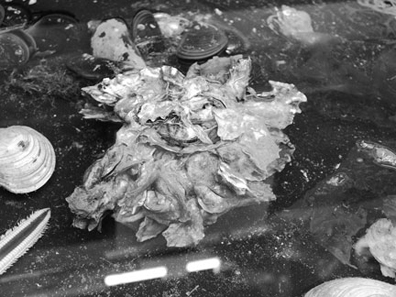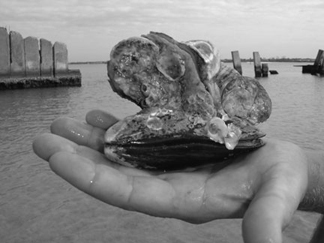

 |
||||||
 |
||||||
Chesapeake Bay Oyster Restoration Gets $2.1 Million Boost
Following record low oyster harvests in Chesapeake Bay, regulators approve a major spending plan that promises a new approach to restoration.
 |
|
Native oysters (Crassostrea Virginica) share a touch tank with invasive green mussels (Perna Viridis) at the Florida Fish and Wildlife Research Institute in St. Petersburg. |
In January, the Virginia Marine Resources Commission approved $2.1 million for oyster restoration following another year of record-low harvests and lackluster recovery attempts.
The recovery plan boosts funding for ongoing “spat-on-shell” efforts in which hatchery-raised or wild oyster larval spat are attached to single shells, then deposited in bay tributaries in clusters or reefs where they are less susceptible to predation and disease. Maryland has utilized the technique successfully for years, and Virginia’s more recent efforts in this regard have encouraged scientists there. Spat-on-shell oysters also figure prominently in Tampa Bay oyster restoration efforts.
For 2007, the funding plan includes $540,000 to plant 28,000 bushels of “seed”oysters in bay tributaries where disease is less prevalent, including the Rappahannock River and two northern Potomac River tributaries. Parasites such as Dermo and MSX have wiped out oyster beds in 80 percent of Maryland’s Chesapeake since the late 1980s. And if oysters didn’t have enough trouble already — surviving the triple-threats of pollution, overharvesting and disease — the mollusk also faces pressure from voracious cow-nosed rays which scarf up baby oysters.”
 |
|
Oysters will attach themselves to any hard substrate, even a blue mussel, as this helping hand demonstrates. Photo courtesy Tampa BayWatch |
Nevertheless, some watermen blame last year’s disappointing harvest on bad weather and onerous regulation, noting an increase in the number of commercial fishermen abandoning oysters to pursue crabs and rockfish.
They also blame competition from outof-state oysters, especially from the Gulf of Mexico, for depressing prices by as much as $5 per bushel from last year’s $20 average.
The new spending plan will give hatcheries an incentive not only to grow larvae but to build the infrastructure to meet increased demand for spat. It also earmarks $200,000 for battling the cow-nosed ray by turning predator into prey and creating a commercial fish market for their meat.
Virginia’s oyster harvest was about 100,000 bushels in 2005; Maryland’s oyster haul was estimated at 70,000 bushels in 2006. Fishermen and regulators acknowledge, however, that actual hauls are likely underreported as watermen bypass seafood dealers and sell directly to restaurants and other customers.
Still, that’s a tiny fraction of the million- plus bushel oyster yields common in the 1970s before overharvesting, disease and pollution decimated the fishery.
Information for this report was compiled from news stories in the Virginian Pilot, Bay Journal, Intrafish, Daily Press and Associated Press.